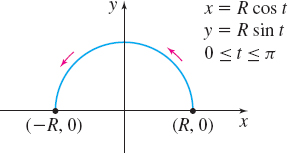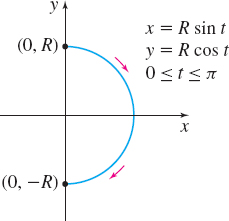EXAMPLE 3Finding a Rectangular Equation for a Plane Curve Represented Parametrically
Find rectangular equations for the plane curves represented by each of the parametric equations. Graph each curve and indicate its orientation.
(a) x(t)=Rcosty(t)=Rsint0≤t≤π and R>0
(b) x(t)=Rsinty(t)=Rcost0≤t≤π and R>0
Solution (a) We eliminate the parameter t using a Pythagorean Identity. cos2t+sin2t=1(xR)2+(yR)2=1cost=xR,sint=yRx2+y2=R2

The rectangular equation represents a circle with radius R and center at the origin. In the parametric equations, 0≤t≤π, so the curve begins when t=0 at the point (R,0), passes through the point (0,R) when t=π2, and ends when t=π at the point (−R,0). The curve is an upper semicircle of radius R with counterclockwise orientation, as shown in Figure 4. If we solve equation (1) for y, we obtain the rectangular equation of the semicircle y=√R2−x2where −R≤x≤R
(b) We eliminate the parameter t as we did in (a), and again we obtain x2+y2=R2

The rectangular equation represents a circle with radius R and center at (0,0). But in the parametric equations, 0≤t≤π, so now the curve begins when t=0 at the point (0,R), passes through the point (R,0) when t=π2, and ends at the point (0,−R) when t=π. The curve is a right semicircle of radius R with a clockwise orientation, as shown in Figure 5. If we solve equation (2) for x, we obtain the rectangular equation of the semicircle x=√R2−y2where −R≤y≤R